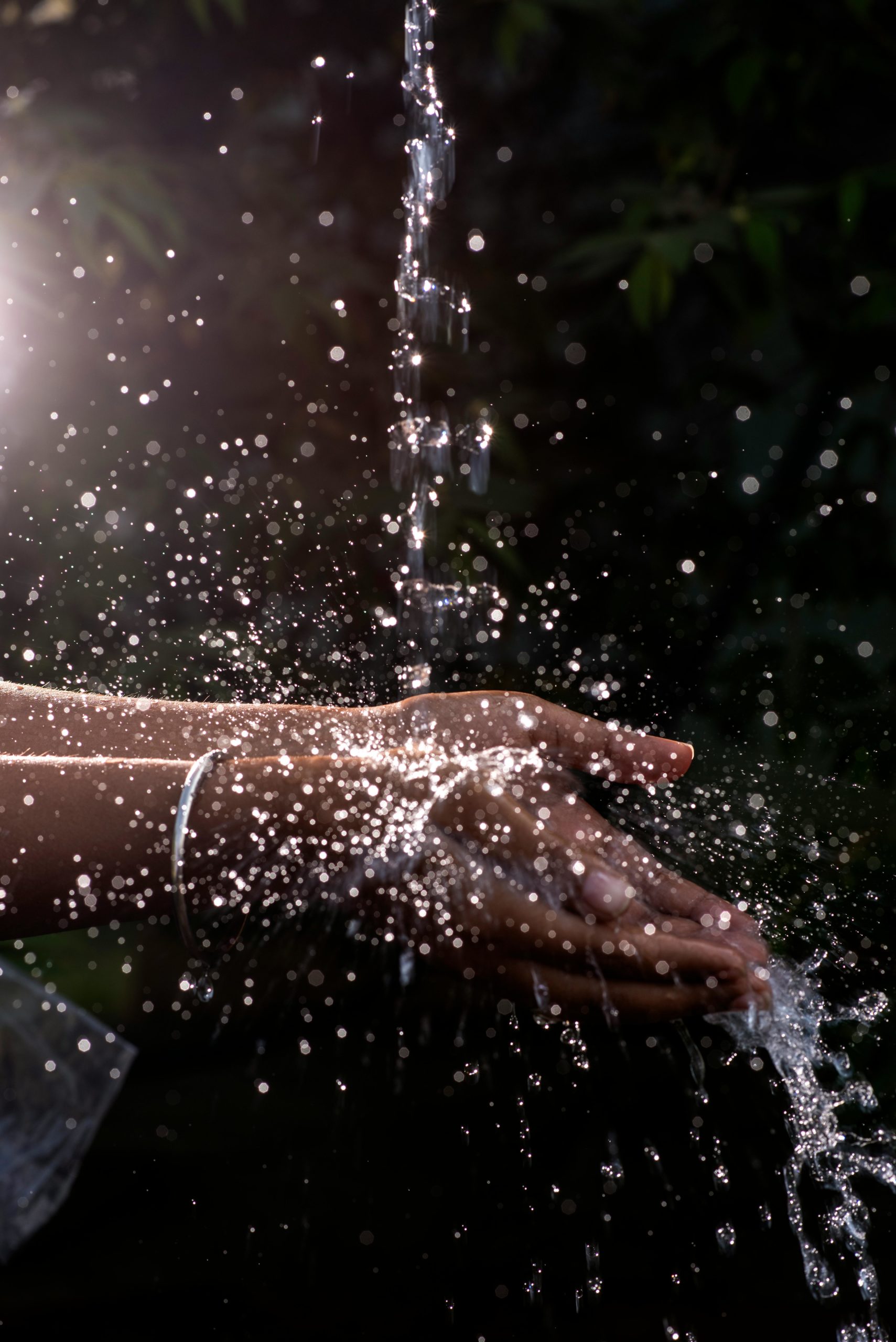Why is this important?
The world’s annual demand for water, at around 4,600 km3, has already reached its maximum renewal capacity. (1) Water demand is expected to further increase by 20 to 30% by 2050 (1). The World Resources Institute estimates that demand for water in 2030 could exceed availability by 56% (2).
Approximately 70% of water consumption is utilised for agriculture, while 22% is utilised for industry. Domestic water use makes up the remaining 8% (3). Domestic water consumption increased by 600% between 1960 and 2014 (2).
Although water covers approximately 71% of our planet’s surface, only 1% is freshwater accessible to humans (4). And its natural renewal cycle of evaporation and precipitation is being disrupted by human activity. Intensive consumption, land artificialisation and climate change are leading to increasingly extreme droughts and floods. The UN estimates that drinking water shortages will affect almost 6 billion people by 2050 (5).
What is the solution?
At the level of an organisation or infrastructure, it is possible to reduce water consumption. The first step is to carry out an analysis of water consumption by workstation, time of year, etc. Detect leaks and repair them. Raise awareness regarding water consumption and help users to reduce their consumption in their premises, homes and activities through simple everyday actions. Install water-saving systems such as aerators, urinals, etc. Recovering and storing grey water or rainwater for reuse after proper treatment will also reduce the amount of water taken from the natural environment.
Last, other indirect actions can be considered, like purchasing products and food with a low water footprint.
Points of attention
-
Points of attention
- Carbon capture technologies use large quantities of aqueous solvents. With a potential reduction of 3 GtCO2 per year (7% of 2019 emissions), they could increase annual water consumption by 35 km3 in 2050 (1).
- Seawater desalination seems an interesting solution to the water problem, but these technologies are energy-intensive and polluting (6).
Key actions
-
#1 Diagnose
Diagnose water consumption and the water distribution network in order to detect possible leaks, misuse, opportunities and other quick wins. Regularly monitor consumption. Install water meters for each building, sector or group of buildings.
-
#2 Reduce losses
25 to 30% of the water treated and sent to the networks is lost in the pipes (8). Look for and repair leaks and reduce opportunities for water loss (taps that leak or push buttons that are left open too long, etc.)
-
#3 Change water consumption habits
Encourage users to reduce their use of water: reduce or avoid washing cars, shorten showers and turn off the water when soaping up (5 to 10 litres consumed per minute), turn off the taps between two actions, reduce the duration and frequency of washing machines, etc.
-
#4 Install water-saving systems
Choose water-saving equipment: flow regulators, flow regulator taps or self-closing taps (with motion detection, push button), dual flush systems for sanitary facilities, urinals (10 times less water than a conventional flush), or dry toilets. Use water-saving drip systems for watering green spaces.
-
#5 Harvest rainwater
Rainwater can be recovered and stored for domestic use, excluding food consumption or personal hygiene (too acidic, unless an appropriate treatment is applied): flushing toilets, washing floors, washing vehicles and watering.
-
#6 Reuse waste water
Micro-treatment plants allow domestic wastewater (grey water = water from showers, dishwashers, washing machines, sinks) to be treated, stored and reused to flush the toilet, clean the house, wash clothes, clean the car and water the garden.
-
#7 Store water
Water needs to be stored for reuse or in the event of a shortage. Underground tanks must be completely watertight and accessible for cleaning. Above-ground tanks must be opaque to prevent the proliferation of bacteria (water + light = life). In general, stored water should circulate and not remain stagnant for too long. Be careful about storing grey water, which is a source of bacteria (e.g. shower water stored for reuse in the toilet).
-
#8 Inform and empower users
To promote more rational water consumption, introduce in-house policies and “good practice” guides to encourage sobriety and make users more aware of their responsibilities. New installations or new rules must be accompanied by a change management approach, with participative sessions and information sessions for all users.
-
#9 Other water-related actions
Reduce hot water consumption, which accounts for 12% of energy consumption. Avoid buying plastic water bottles, and prefer reusable 20-litre glass bottles or ceramic filters, etc. Treat wastewater and avoid toxic discharges into water. Adopt a planetary health diet by favouring plant-based meals, which consume less water (9). Favour purchases from producers using water-saving techniques (drip irrigation, etc).
To consider
-
Potential co-benefits
- Lower water bills
- Lower energy bills (for hot water)
- Reducing water shortages
- Improving our ability to cope with shortages
- Amplified impact if these eco-actions are adopted at home
-
Conditions for success
- Regular maintenance of water networks (leak detection, repairs)
- Adapting measures to the context (climate, local cultures, infrastructure constraints, etc.)
- Raising staff awareness
-
Prerequisites and special features
- Initial investment (meters, repairs, new taps or flushing systems, droppers, etc.)
- Comply with good practice to avoid pollution and health hazards (in particular storing and reusing water)
-
Potential risks
- Proliferation of bacteria if grey water reuse and water storage are poorly implemented
- Rainwater has a high acidity level and needs to be pre-treated for personal hygiene or drinking purposes
- Possible deterioration in the quality of stored water if conditions are not right (sedimentation, accumulation of organic debris, etc.)
Tools and best practices
-
ADEME: a guide to better water conservation and sharing, 2023, (FR)
The French Agency for Ecological Transition has published this guide to conserving water in the event of drought.
Explore here -
Water footprint calculator and educational resources, 2017
Ecorise is an American organisation that develops resources to educate and raise awareness of environmental issues. Its watercalculator site offers information, articles, quizzes and other links on water resources, as well as a water footprint calculator.
Explore here -
An example of the Water Use Policy of the University of Surrey, 2023
The UK's University of Surrey has published its water management policy document online to share best practice.
Explore here -
Ademe video "Freshwater and its availability in the world", 2021, (FR)
The French Agency for Ecological Transition has published this video to raise public awareness of freshwater management.
Explore here -
Video on the uses of water, UNESCO, 2015
This UNESCO video shows the impact of human activity on the quantity and uses of freshwater around the world.
Explore here -
The water savings club, (FR)
Created by the French Ministry for Ecological Transition, the club for best practice in water savings and pricing, run by the French national Federation of conceding authorities, is helping to achieve the target of reducing water consumption by 10% over 5 years and 25% over 15 years.
Explore here -
UNEP Green Infrastructure: a guide to water management, 2014
This guide presents simple but little-known natural or semi-natural solutions for better management of water resources, with case studies.
Explore here
Further reading
-
Interactive map of world water consumption
UN Water updates interactive online maps on water consumption and water stress around the world.
Explore here -
CEO's guide to building a water resilient business, 2018
The CEO of the World Business Council for Sustainable Development is proposing a guide to help businesses reduce their water consumption.
Explore here -
Investing 1% of the world's gross domestic product could solve the water crisis, 2020
The World Resources Institute estimates that by investing 1% of the world’s gross domestic product, the water crisis could be solved.
Explore here -
Data about Water from UNEP, 2017
Data and overview about Fresh water, published by UNEP.
Explore here
Updated
Last updated 4 September 2025.
Share your success stories, suggestions, and comments with us! contact@climateactionaccelerator.org
Sources
(1) IPCC, ‘Chapter 4 : Water’, IPCC, Available here, (accessed 4 September 2025).
(2) Otto, B., and Schleifer, L., ‘Domestic Water Use Grew 600% over the Past 50 Years’, World Resource Institute, 2020, Available here, (accessed 4 September 2025).
(3) Aivazidou, E., et al., ‘The emerging rôle of water footprint in supply chain management : A critical literature synthesis and a hierarchal decision-making framework.’, Journal of Cleaner Production, 2016, Available here, (accessed 4 September 2025).
(4) Water Science School, ‘How Much Water is There on Earth?’, USGS, 2019, Available here, (accessed 4 September 2025).
(5) UNESCO, ‘Rapport Mondial des Nations Unies sur la mise en œuvre des ressources en eau 2018 : les solutions fondées sur la nature pour la gestion de l’eau’, UNESCO, 2024, Available here, (accessed 4 September 2025).
(6) Elsaid, K., et al., ‘Environmental impact of desalination technologies : A review’, Science of The Total Environment, 2020, Available here, (accessed 4 September 2025).
(7) WHO, ‘Water’, WHO, Available here, (accessed 4 September 2025).
(8) RFI, ‘La crise de l’eau en 5 questions’, RFI, 2018, Available here, (accessed 4 September 2025).
(9) Springmann, M., et al., ‘Options for Keeping the Food System within Environmental Limits’, Nature, 2018, Available here, (accessed 4 September 2025).
(10) CHU Poitiers, ‘Le CHU des Poitiers récompensé pour ses économies d’eau’, CHU Poitiers, 2021, Available here, (accessed 4 September 2025).
(11) University of Surrey, ‘Reducing our Water Consumption’, University of Surrey, Available here, (accessed 4 September 2025).
Featured
Water

Rainwater harvesting

Dry toilets

Renaturing urban premises

Ecosystems

Nature-friendly practices

Credits
Cover photo: Farooq Khan/Pexels
